| 1 | One of the most common boas |
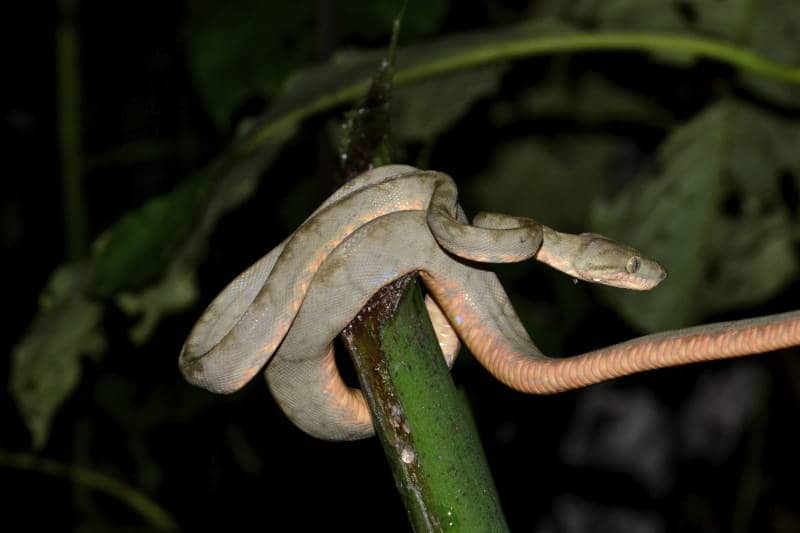
This is a species of forests, at home in rainforests and semi-disturbed forests alike. They never appear in towns, but sometimes invade the roofs of village houses directly next to forests. This snake spends most of its time on tree branches, waiting in ambush for prey. Their average branch height is 1-2 metres, but they can climb much higher, sometimes resting in tree crowns at 25 metres.
Amazon tree boas particularly like branches overhanging small forest streams, often murky-looking waters with gnarly twisting roots spreading into the centre. While they’re far more airborne than boa constrictors, they spend less time in trees compared to their emerald tree boa cousin, which only flees from its branches in extreme distress. Amazon tree boas often drop to the ground to hunt, or journey to a more favourable tree.
| 2 | Preys on the entire rainforest |
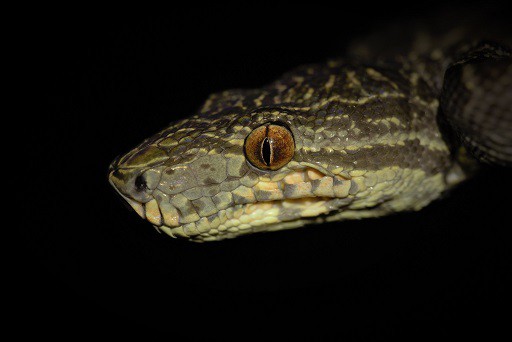
The Amazon tree boa is an extremely unfussy eater. Some snakes are barely researched in their diet; they might have a vague tag of “rats” or “birds”, but nothing specific. Meanwhile, the Amazon tree boa has a gigantic amount of specific animals it’s confirmed to eat, in surveys by scientists. This includes:
Rodents – South American water rat, Atlantic forest climbing mouse, Hylaeamys perenensis.
Marsupials – Brazilian gracile opossum, woolly mouse opossum, Linnaeus’ mouse opossum, southeastern four eyed opossum, bare-tailed woolly opossum.
Bats – black myotis, Jamaican fruit bat, dark-fruit eating bat.
Birds – great kiskadee, purple gallinule, great ani, black ani, white-banded swallow, red-rumped cacique, sayacer tanager.
Reptiles – green iguana, giant ameiva.
Nearly 60% of the Amazon tree boa’s diet consists of mammals, according to one study. They’re like a vacuum cleaner, but they do have some preference. Amazon tree boas mainly hunt via ambush, swinging down from their branches while anchored with a prehensile tail. However, they use active foraging more than their emerald tree boa relative, jumping down to scout the rainforest floor.
| 3 | Hunts stealthily by streams |
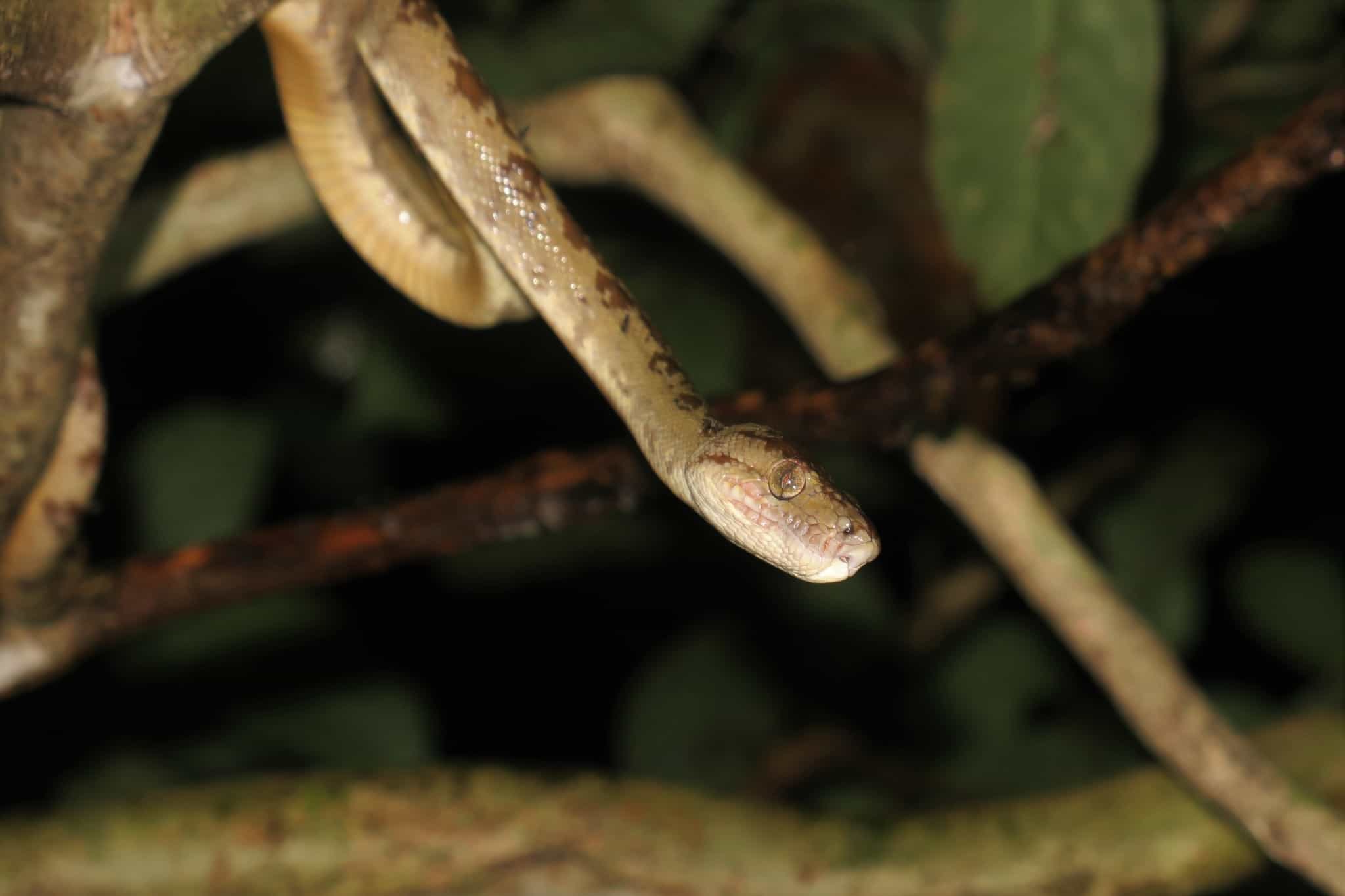
Amazon tree boas are nocturnal and hunt almost entirely at night, under a shield of invisibility which disguises them against predators. Keepers have found that captive Amazon tree boas refuse to eat unless the cage is pitch black. Corallus hortulanus locks onto its prey with sharp, syringe-like teeth, often biting savagely into the back of the head, and delivering a second bite if the prey struggles.
When foraging actively, their favourite spot is vegetation along the margins of rivers. Once they’ve seized a prey by the head, the Amazon tree boa takes 15-30 minutes to complete the swallowing process. Then they retreat upwards to the shelter of a canopy, and spend 7 days slowly digesting their meal while barely moving. Their most active period of the day is 18:00-24:00pm, becoming more sluggish between midnight and 5:00am.
The Amazon tree boa can be a bit of an idiot at times, as scientists have found their bodies covered with painful spikes, after a failed attempt to eat a porcupine. They can be clumsy too, dropping their prey into a pile of leaves and being forced to climb back down and pick them up again.
| 4 | Bat-snatcher |
Amazon tree boas are one of the snakes confirmed to feed on bats, like their Cuban boa relative in the Caribbean. Most bat-hunting snakes wait by the dark entrances of caves, to ambush roosting colonies when they fly out in their thousands. Amazon tree boas work differently, waiting near the flowers and fruits which the bats eat. They also slither into village roofs, and even invade scientific research stations attempting to study bats.
An Amazon tree boa’s general hunting strategy is to dangle below the branch in an s-shape, then force the prey off the branch above so that they land in a prison of coils. This is different to the emerald tree boa, which prefers to stay above, and rest its head in its own coils like a nest.
Amazon tree boas can strike at prey a surprising distance away. When swallowing prey, they make contractions in their body to force it further down. One weird tendency is to anchor their tail on a branch over rainforest streams, drop down, and submerge their head below the water surface for several minutes. It’s possible that they’re hunting for fish, although it isn’t a large part of their diet. Amazon tree boas also have predators of their own, including barn owls and crowned dwarf caimans.
| 5 | Rumoured to be vicious |
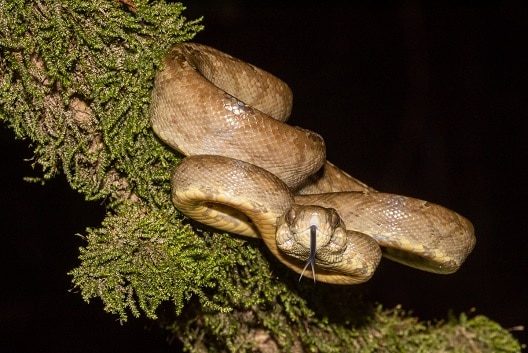
Amazon tree boas have a bad reputation among reptile keepers. They’re supposedly one of the most aggressive non-venomous snakes, biting and hissing and refusing to calm down even after years of friendship. This has hung like a black shadow over them, but views are mixed nowadays.
Some enthusiasts confirm that they’re more aggressive than an Australian carpet python, particularly when held. They’re definitely nippy when younger, placing a small bite in your arm in a fit of nerves. However, others have called them their most peaceful pet, and argue that they calm down rapidly if cared for properly. It’s possible that Corallus hortulanus merely requires more adjustment to human contact than others – hence the vicious stories from the wild. Amazon tree boas apparently operate on a respect basis: if they sense your nerves, they too will get nervous and therefore snappy. If you stay confident and look them in the eye, then you’ll receive it back in kind.
Keepers also testify that Amazon tree boas are a curious snake, which often crane forward to investigate a new object. When disturbed, they tend to cock their head back – learn to read the signs.
| 6 | Hates the moon |
The Amazon tree boa has one enemy it can never outsmart: the moon, 384,400 km above its head. Amazon tree boas are much harder to find during full moonlight, and they’ll only forage in the deep shadows. For example, a large study on three islands in Brazil encountered the snake 1320 times, gathering diet and habitat information. 795 of those encounters took place on moonless nights.
The poorer the visibility the better, as this allows them to move under the noses of hungry barn owls undetected. Amazon tree boas themselves have excellent night vision, infiltrating juicy shrubs like a silent jungle spy. There’s a compounding factor as well; many of their bird prey like great anis and great kiskadees also prefer cloudless nights, so it gives the snake a higher chance of a meal. During full moon, they also retreat further up their trees, resting at 2.3-4.1 metres versus 1.2-1.9m.
Despite liking cloudy nights, Amazon tree boas also dislike rain. The first raindrops send them scampering to cover beneath thick flowering plants on the ground, rainforest plants such as Montrichardia linifera.
| 7 | A snake of many morphs |
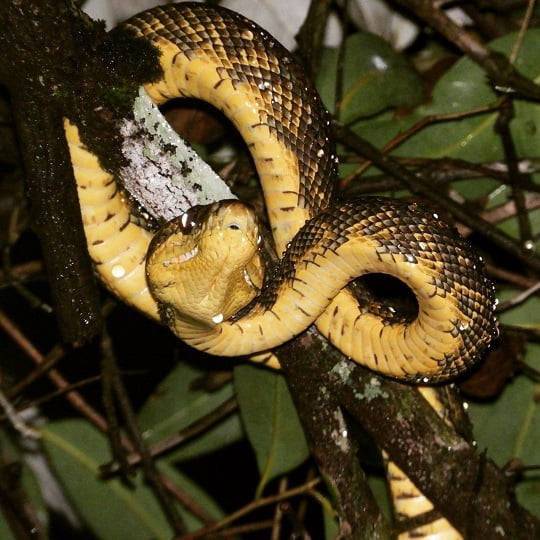
One of the Amazon tree boa’s signature features is its massive natural variety. The colours vary like an artist’s paint palette, and even the patterns vary from circled, to banded, to random miscellaneous patches.
The most common is grey, AKA the “forest” variety. A Brazilian study found that in two random jungle locations, Camaleões and Baixão creeks, the colours were 65% grey, 30% dark orange, and 5% yellow. In Guirindó creek, the Amazon tree boas were 50% grey, 40% dark orange, and 10% yellow. These are the three main colours, but every so often the jungle will spit out a completely random one. Many of the craziest morphs in the pet trade weren’t bred deliberately, but were picked up in the wild, and only then bred to pass the genes on.
For example, the tiger morph only has vivid orange and black colours. It was discovered in the 1990s when an enthusiast spotted an extremely black Amazon tree boa in a collection of wild imports. The gene proved to be co-dominant, meaning that just one tiger parent is required to pass some of the colours on to its Amazon tree boa children. With the other original parent being non-tiger, the resulting descendants now have ever-varying ratios of orange and black, creating the “tiger” look. These are popular in the pet trade, and the orange colours also spread to their eyes.
| 8 | Unusually sharp eyesight |
Infrared vision is a fairly common feature in snakes, despite most humans requiring special goggles from the CIA to use it (we’re still waiting for the gene to evolve naturally). The likes of rattlesnakes and mamushis have heat-seeking pits in their faces, which contain a special IR-detecting membrane. In the Amazon tree boa, those pits are more like chasms. Amazon tree boas have particularly good eyesight for a snake, and their infrared sensing is well beyond most of their relatives.
It’s this super-vision which allows them to fare so well on moonless nights. The original studies date back to 1937, and found that Amazon tree boas have an abundance of unmyelinated nerve fibres in their facial pits. These ended with “knoblike enlargements”, which were supplied with an abundance of blood from capillaries, presumably creating a constantly high sensitivity.
Another feature of their eyes is a reflective membrane, which reflects torchlight back. In rainforest outskirts, many explorers have only noticed Amazon tree boas after a random glare of light from the trees.
| 9 | Thwarted by ants |
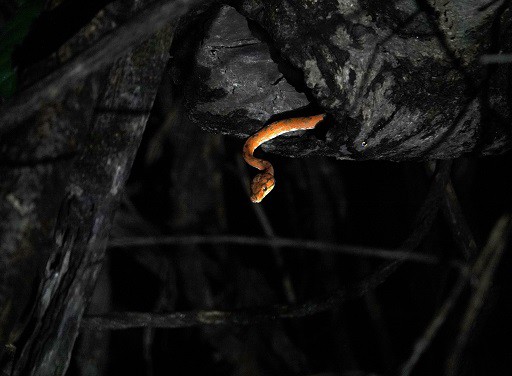
Amazon tree boas give birth to live young, which are independent from the first second. They shed their skin for the first time at 8 to 14 days old. Amazon tree boas have been observed (read: spied on) mating a few times, and the males and females always have a precise 5 coils around each other.
In one observation, the pairs’ heads were facing completely apart, in the opposite directions. Every few minutes, the male’s head would swivel around and rub its jaw on the back of the female’s neck, before facing away again. This happened on a tree branch near a river.
A rainforest is an equation with thousands of possible inputs, and one weird event happened while the Amazon tree boa hunted an opossum. The animal was in its jaws, and the snake prepared to swallow, but then a swarm of biting ants, lured in eagerly by the opossum, began to crawl all over the snake’s body. The shocked snake was bitten on the jaw, and started banging its head hard against the ground to shake the ants off. The boa just clung onto the opossum, and fled up a cashew tree. When it was safe, it swallowed the opossum in 13 minutes.
| 10 | Needle-thin fangs |
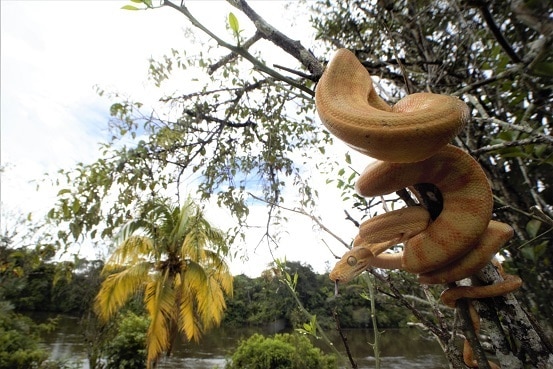
The emerald tree boa begins life as red and transitions to green, but Amazon tree boas are a constant colour all their lives. Another difference between the two cousins is that emerald tree boas have brutally long front fangs, the longest of any non-venomous snake, which can cause blood to spirt out of the wrist of a keeper in perfect time with their heartbeat. An Amazon tree boa’s fangs are sharp, but shorter and needle thin.
Amazon tree boas are mid-length for the Corallus family, at 1.5-2 metres, and their bodies are relatively thin. Males and females are roughly equal in size, and the species has a blue-black tongue.
In 2002, 3000 Amazon tree boas were exported from Guiana, and 1902 were exported from Suriname. The export trade is believed to be perfectly sustainable. The species has a “least concern” IUCN conservation tag, and its total territory is estimated at 207,837 km2. If there is a problem, it’s deforestation, as Amazon tree boas may stray to the margins of forests, but never beyond. This is yet another species whose home is steadily shrinking. The boa constrictor is more flexible, slithering through plains and fields.
